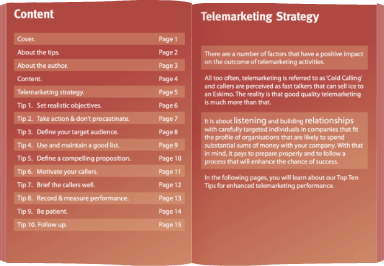It seems like telemarketing has been around forever. It has been called many things such as cold calling, telesales, prospecting, tele calling and a few other derivatives. Ultimately, though, it involves a caller picking up the phone to reach out to another individual with the intention of, ultimately, selling something.
Outbound calling gets a bad name
Yet, to simplify telemarketing in that way does it a big disservice. This makes the assumption that it is a short-term sales pitch, and that the seller is not interested in the buyer at all. That approach is the worst type of selling and it’s what has earned outbound calling a bad name over many years.
Effective B2B telemarketers, that are the highest achievers, don’t operate that way. They demonstrate genuine interest in their prospects and are adept at asking excellent questions, listening and sharing information.
A good caller understands that prospecting is a two-way exchange. It isn’t a sales pitch. It’s essential that the recipient of the call feels valued. The caller needs to build rapport very swiftly or the likelihood is that the phone will go down early in the call.
Using events as a trigger
Having a reason for your call is essential and events are an excellent way to start to build a level of engagement. There are several types that benefit from telephone contact to either encourage attendance or to follow up the day.
- Exhibitions where your company exhibits, attends or speaks
- Conferences
- Webinars
- Seminars
- Round-tables
- Workshops
Each of the above has a different style and objective, but usually, the overall aim is the same. The purpose is to generate interest in the types of products and services that you offer. This could lead to short-term sales or longer-term engagement that leads to a future opportunity.
Some are opportunities to sell from a stand whereas others are more about knowledge-sharing. Regardless of the nature of your particular event, the ideal situation is to encourage a steady stream of relevant potential buyers to engage with your sales personnel.
Where do exhibitors go wrong?
Whilst it is entirely logical to feel that it is the exhibition organisers’ role to generate attendance at large exhibitions, that isn’t the whole story. You should not rely on this since you don’t always know the profile of attendees and you can’t guarantee that they will swing by your stand.
For webinars, round-tables, or workshops that your company organises, you don’t have the luxury to rely on the organisers to drive attendance. Hence, you need to pull out all the stops to make sure you have high levels of attendance.
Visibility is key
Whether you ensure your stand is well-placed or place an advert in the show brochure or you provide some eye-catching gimmick on your stand to attract attention, you need to be visible. And, if you need attendees for a webinar or seminar, and these include prospects as opposed to customers, you need sufficient marketing activity to generate the required number of delegates.
For customer events, it may be easier, all the while accepting that customers are busy, often need to travel and will only attend if it is relevant and interesting.
Timing is essential
With busy calendars, and inevitable drop-outs, timing is key. Usually, it helps to allow 6-8 weeks ahead of the day to kick-start your marketing activity. If you can allow for more, all the better. And, if you run several sessions throughout the year, it helps to offer choice in case your customer cannot attend on a specific date.
Plan your outreach
How are you going to get bums on seats? And, how are you going to maximise the value of your investment? Essentially, there are three elements to this, namely:
- Before
- During
- After
It’s pretty obvious really. One would hope that a schedule of activity includes a number of marketing tools across all three timeframes. Once again, this depends on the nature of the activity. Pre-show offers, presence on the show website, and activities on your stand all support engagement and data capture. Ultimately, you want to reel in as many targeted prospects as possible.
Email outreach is often a core part of most activities in advance of whichever form of event you’re running or in which you are participating. Naturally, success rates will depend on the relevance of the agenda, and on the quality of data used for marketing outreach.
Nurturing using some form of automation is also important in addition to regular reminders ahead of the day.
Direct messaging is important
Getting in front of as many targeted audiences is vital. Some of this will come from staff engagement with customers, from newsletters, LinkedIn posts and other methods. However, the level of investment on events is usually significant. Hence, the more outreach you can generate the better in order to maximise the ROI.
That’s why we always encourage the use of LinkedIn direct messaging. If you have Sales Navigator, that allows you to build lists for targeting. You can also reach out using InMail, via groups and by connecting and messaging the right audiences.
Why is the phone your secret weapon?
Telemarketing is hardly new. Yet, perhaps the most overlooked aspect to its use for events is its ability to laser target individual prospects. That’s not to say you can guarantee to speak to everyone you call. However, if you understand your audience, it’s likely that you can build a robust target list of the right kinds of prospects for your business. And, alongside email marketing and LinkedIn, you can reach out to precisely the right individuals to encourage them to attend.
The specific strategy will differ depending on the nature of the activity whether it’s an exhibition, webinar, conference or whatever. Yet, what’s certain is that you can tailor messages and create a positive impression of your business even if they aren’t ultimately able to attend. Engaging with prospects and customers for something that is relevant, timely and interesting is one of the best methods of lead generation. What’s more, the higher the value of what you sell, the more important it is to get in front of the right people and that’s where human contact is vital in the sales process.
Remember the ‘before and after’
As indicated above, it’s important to reach out in advance of the day to encourage attendance. But, it’s even more crucial to follow-up straight after the event as soon as possible. And, that means days not weeks. If you’re fortunate enough to generate a good number of leads, these prospects will go cold very quickly if you don’t call them in the few days after you’ve met them. Other priorities kick in. Interest can cool. You also need to filter genuine prospects from those just wasting your time.
If your sales team has the bandwidth to make those initial calls, that’s great. However, it’s often not the first or second call that counts. It’s the ongoing management of this important sales lead pipeline that matters. Further prospect qualification following the event is important. Calling back at the right time is essential. That could include those calls that take place weeks and months afterwards.
Don’t allow lack of follow-up to damage the value of all of your hard work and effort.
Ultimately, the time devoted to making sure that no prospect or customer is left hanging after this potentially expensive form of marketing activity is a worthwhile investment. And, usually, it’s best accomplished by picking up the phone and not relying on email automation to do the job.






